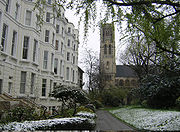
Colville Gardens
Encyclopedia

Victorian architecture
The term Victorian architecture refers collectively to several architectural styles employed predominantly during the middle and late 19th century. The period that it indicates may slightly overlap the actual reign, 20 June 1837 – 22 January 1901, of Queen Victoria. This represents the British and...
cul-de-sac street in the Royal Borough of Kensington and Chelsea, located north of Colville Terrace and east of the Portobello Market in Notting Hill
Notting Hill
Notting Hill is an area in London, England, close to the north-western corner of Kensington Gardens, in the Royal Borough of Kensington and Chelsea...
, London
London
London is the capital city of :England and the :United Kingdom, the largest metropolitan area in the United Kingdom, and the largest urban zone in the European Union by most measures. Located on the River Thames, London has been a major settlement for two millennia, its history going back to its...
, England
England
England is a country that is part of the United Kingdom. It shares land borders with Scotland to the north and Wales to the west; the Irish Sea is to the north west, the Celtic Sea to the south west, with the North Sea to the east and the English Channel to the south separating it from continental...
. It is bordered on the north side by All Saints
All Saints Notting Hill
All Saints Notting Hill is a Victorian Anglican church in Talbot Road, Notting Hill, London. It is a Grade II* listed building, built of stone with polychrome decoration in the Victorian gothic style. The west tower has five stages with the stump of a spire, and the sanctuary features paintings by...
church.
History
Colville Gardens was initially laid out in the 1870s by the builder George Frederick TippettGeorge Frederick Tippett
George Frederick Tippett was a Victorian builder and enterpreneur who developed much of the former St Quintin Estate in Notting Hill, London. He is responsible for the construction of many buildings in the area which remain today, including Pinehurst Court, a portered Victorian mansion block at...
, who also developed much of the rest of the neighbourhood. The houses were intended as single family homes for the well-to-do but from the beginning it proved difficult to attract wealthy buyers to the area, and as early as 1888 the buildings began to be subdivided into flats.
In 1885 Tippett was declared bankrupt. He attributed his failure to "his inability to let a large portion of his property and to the pressure of secured creditors". Gradually the character of the buildings changed as wealthier tenants left the area.
By 1928 the neighbourhood was described as "rapidly becoming poorer", and by 1935 as a "largely slum area...large houses turned into one-room tenements and small flats".
Further decline set in as residents moved away during World War II
World War II
World War II, or the Second World War , was a global conflict lasting from 1939 to 1945, involving most of the world's nations—including all of the great powers—eventually forming two opposing military alliances: the Allies and the Axis...
to escape The Blitz
The Blitz
The Blitz was the sustained strategic bombing of Britain by Nazi Germany between 7 September 1940 and 10 May 1941, during the Second World War. The city of London was bombed by the Luftwaffe for 76 consecutive nights and many towns and cities across the country followed...
, and indeed one of the buildings at the end of the street was destroyed by bombing, which also damaged numerous other buildings including All Saint's Church.
The street continued to deteriorate in the 1960s and 1970s along with the rest of Notting Hill, and the neighbourhood became notorious for the predatory business practices of slum landlord Peter Rachman
Peter Rachman
Peter Rachman was a London landlord in the Notting Hill area in the 1950s and 1960s. He became so notorious for his exploitation of tenants that the word "Rachmanism" entered the OED as a synonym for any greedy, unscrupulous landlord.-Career:Rachman was born Perec Rachman in Lvov, Poland in 1919,...
. However, from the 1980s onwards the street gradually improved, reflecting the general revival of Notting Hill in recent years. 1-9 Colville Gardens, formerly a notorious slum building, was rebranded as Pinehurst Court
Pinehurst Court
Pinehurst Court is a portered Victorian mansion block at 1-9 Colville Gardens, just off Colville Terrace and near the Portobello Market in Notting Hill, London, England.-History:...
in the 1970s and now comprises around 105 one and two bedroom flats, mostly leased to private tenants on long leases of 100 years or more. The building is currently well maintained and forms a part of one of London's most fashionable neighbourhoods.
Notable residents
- John GawsworthJohn GawsworthJohn Gawsworth , a pseudonym of Terence Ian Fytton Armstrong , was a British writer, poet and compiler of anthologies, both of poetry and of short stories. He also used the pseudonym Orpheus Scrannel...
(1912–1970), writer, poet and compiler of anthologies, grew up in Colville Gardens. He was crowned the king of the tiny CaribbeanCaribbeanThe Caribbean is a crescent-shaped group of islands more than 2,000 miles long separating the Gulf of Mexico and the Caribbean Sea, to the west and south, from the Atlantic Ocean, to the east and north...
island of RedondaRedondaRedonda is a very small, uninhabited Caribbean island which is part of Antigua and Barbuda, in the Leeward Islands, West Indies.This small island lies southwest of Antigua, in the waters between the islands of Nevis and Montserrat...
in 1947, and became known as King Juan I. His real name was Terence Ian Fytton Armstrong.
See also
- Notting HillNotting HillNotting Hill is an area in London, England, close to the north-western corner of Kensington Gardens, in the Royal Borough of Kensington and Chelsea...
- Pinehurst CourtPinehurst CourtPinehurst Court is a portered Victorian mansion block at 1-9 Colville Gardens, just off Colville Terrace and near the Portobello Market in Notting Hill, London, England.-History:...

